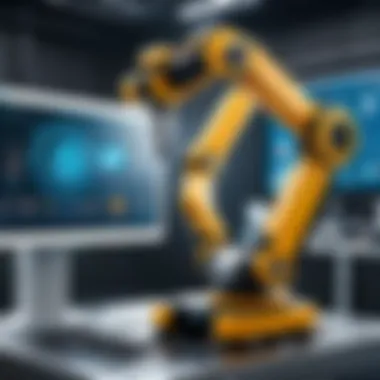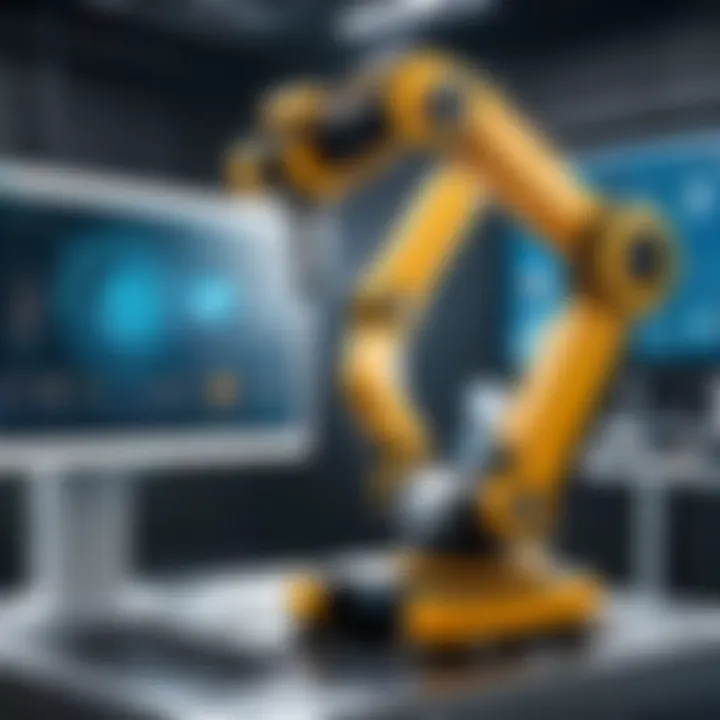Engineering Innovations of 2021: Key Insights and Trends


Intro
Engineering has always been at the forefront of societal advancement. The innovations that bloom in a single year can lay the groundwork for changes that define decades. In 2021, a notable array of engineering innovations emerged, influencing various sectors including manufacturing, aerospace, and renewable energy. This article provides an in-depth analysis of key advancements, their significant impacts on businesses, and the potential trends that will guide future development.
This exploration not only highlights how technology has shaped engineering practices but also emphasizes the crucial implications for industries worldwide.
Technological Research Overview
Recent Technological Innovations
The year 2021 witnessed groundbreaking developments in engineering that serve diverse functionalities. Notably, advancements in additive manufacturing, often referred to as 3D printing, escalated in complexity and application. Technologies such as metal 3D printing gained traction in aerospace and automotive sectors, allowing for lightweight and efficient designs.
Another impactful innovation came from AI-enhanced simulation tools. These tools streamline design processes and improve product testing, leading to faster turnarounds and enhanced reliability. For example, the integration of AI with computational fluid dynamics enables engineers to optimize designs without extensive physical testing.
Impact on Business Operations
The integration of these innovations significantly altered business operations. Companies adopted more efficient manufacturing techniques, reducing both time and resource consumption. The increase in remote operations, fostered by digital communication and collaboration tools, allowed teams to innovate without geographical constraints.
"2021 showed that flexibility and rapid adaptation are key to sustaining business success, especially during unpredictable times."
In addition, data analytics played a vital role. Businesses could leverage data insights to inform decision-making processes, optimize supply chains, and enhance customer experiences. Organizations that embraced these changes reported improved profitability and competitiveness.
Future Technological Trends
As we move forward, several trends are anticipated to shape the engineering landscape. Firstly, sustainable engineering practices will become paramount, propelled by increasing concerns around climate change. Innovations in renewable energy technologies, such as solar and wind energy, will likely continue to evolve, offering cleaner alternatives to traditional power sources. Additionally, developments in electric vehicle technology and storage solutions are expected to gain momentum.
Furthermore, the application of AI and machine learning in predictive analytics will transform industries by enhancing operational efficiencies and driving innovation.
Data Analytics in Business
Importance of Data Analytics
In modern engineering, the role of data analytics cannot be overstated. It enables organizations to extract meaningful information from large data sets, leading to informed decision-making. Companies harness analytics to identify inefficiencies, predict market trends, and personalize customer experiences.
Tools for Data Analysis
A range of tools emerged in 2021 that facilitate data analysis. Platforms such as Tableau and Microsoft Power BI empower users to visualize data effectively. Moreover, programming languages like Python and R continue to dominate for statistical analysis and machine learning applications.
Case Studies on Data-Driven Decisions
Numerous organizations have achieved remarkable results through data-driven strategies.
- General Electric harnessed data analytics to optimize aviation engines, resulting in improved fuel efficiency.
- Tesla employed data insights to enhance vehicle performance and autonomous driving capabilities.
- Amazon utilized predictive analytics to tailor its inventory based on consumer purchasing patterns, resulting in increased sales.
Cybersecurity Insights
Threat Landscape Analysis
As technology advances, so do cyber threats. In 2021, organizations faced increased cyberattacks, highlighting the importance of robust cybersecurity measures. These threats included ransomware attacks and phishing scams targeting sensitive company data.
Best Practices for Cybersecurity
To mitigate risks, companies should implement several best practices:
- Regularly update software and systems.
- Conduct employee training on recognizing potential threats.
- Establish a comprehensive incident response plan.
Regulatory Compliance in Cybersecurity
With rising threats, regulatory bodies introduced stricter compliance measures. Organizations must adhere to guidelines such as the General Data Protection Regulation (GDPR) and the Cybersecurity Framework by the National Institute of Standards and Technology (NIST).
Artificial Intelligence Applications
AI in Business Automation
Artificial Intelligence increasingly plays a pivotal role in automating business processes. In 2021, AI applications expanded in customer service through chatbots and virtual assistants. This development improved response times and reduced operational costs.
AI Algorithms and Applications
Various algorithms underpin these advancements. Machine learning and neural networks facilitate predictive analytics, enhancing decision-making across different sectors. For example, algorithms analyze consumer behavior patterns to recommend products in real-time.
Ethical Considerations in AI
However, the rapid adoption of AI raises ethical issues. Concerns regarding bias in algorithms, transparency, and job displacement persist. Companies must address these considerations as they integrate AI into their business models.
Industry-Specific Research
Tech Research in Finance Sector
In finance, innovations like blockchain technology revolutionized transactions and payment systems. Secure and transparent ledgers enhance trust and efficiency in financial dealings.


Healthcare Technological Advancements
The healthcare sector benefitted through telemedicine and AI diagnostics. In 2021, patient remote monitoring became prominent, allowing healthcare professionals to deliver care effectively, even from a distance.
Retail Industry Tech Solutions
Retailers adopted various technological solutions for inventory management and customer engagement. Data analytics enabled personalized shopping experiences, increasing customer satisfaction and loyalty.
In summary, the innovations of 2021 are far-reaching, affecting various engineering disciplines and business operations. Understanding these developments paves the way for addressing future challenges and maximizing opportunities in an ever-evolving landscape.
Preface to Engineering Innovations
The field of engineering constantly faces the dual challenge of advancing technology and meeting societal needs. As we look back at 2021, it is essential to understand how new ideas transformed the engineering landscape. This section focuses on engineering innovations, defining what they encompass and why they hold great significance in the modern world.
Defining Engineering Innovations
Engineering innovations can be understood as new or improved processes, products, or systems that bring about increased efficiency, sustainability, or functionality. They often stem from a need to solve existing problems or to meet evolving standards and expectations. The innovations of 2021 showcased a variety of advancements across different sectors, from manufacturing to civil engineering. This diverse range illustrates that engineering is not just about building structures or machines; it is about creating solutions that positively impact people’s lives.
The Importance of Innovation in Engineering
Innovation in engineering is critical for several reasons. Firstly, it drives economic growth by enabling companies to become more competitive. When businesses adopt new technologies, they can improve productivity and ultimately reduce costs. This can result in lower prices for consumers and higher profit margins for companies.
Secondly, innovations often lead to enhanced sustainability. As climate change becomes an urgent issue, engineering must adapt to develop technologies that minimize environmental impact. This is evident in the adoption of green engineering practices, which not only address environmental concerns but also comply with emerging regulations.
Thirdly, through innovative methodologies, engineering can enhance safety and reliability. Advancements in design and materials can reduce risks associated with various engineering projects. Improved safety protocols and more robust infrastructure can prevent disasters and save lives.
"Innovation in engineering not only transforms industries but also uplifts entire communities by improving quality of life."
Key Trends in Engineering for
Understanding key trends in engineering for 2021 is vital because they reflect the dynamic nature of the industry. These trends illustrate how engineering adapts to societal needs and technological advancements. A focus on sustainability, digital transformation, and design resilience emerges as primary strategies to ensure long-term success. In an era marked by environmental concerns and technological upheaval, these elements are more than trends; they are essential factors influencing every engineering discipline.
Sustainability and Green Engineering
Sustainability in engineering has gained unprecedented importance. The focus is shifting towards integrating eco-friendly practices in all projects. This means minimizing environmental impacts. For instance, construction companies are now seeking to reduce waste and carbon footprints. Using materials that are either recycled or easily recyclable is becoming standard practice.
Additionally, many engineering firms aim to develop energy-efficient systems. These systems reduce operational costs over time. This trend is driven by regulations and public demand for accountability in environmental stewardship. Engineers are increasingly tasked with creating designs that align with sustainable ideals. They must adopt green engineering principles for various applications across sectors.
Digital Transformation in Engineering
Digital transformation continues to reshape the engineering landscape. This trend encompasses advanced technologies such as artificial intelligence and the Internet of Things. These technologies facilitate new methodologies in project management and design processes.
Utilizing data analytics enhances decision-making. This, in turn, leads to optimized performance. Engineers who embrace digital tools can streamline operations. For instance, Building Information Modeling (BIM) is now prevalent in civil engineering. This technology allows teams to work collaboratively on real-time data, reducing the risk of errors.
Moreover, adopting these technologies can lead to significant cost savings. Automation and enhanced communication channels ensure projects are completed efficiently. Companies that fail to adapt may find themselves at a competitive disadvantage.
Resilience in Engineering Design
Resilience in engineering design is another crucial trend. The focus here is to create structures and systems capable of enduring adverse conditions. This applies to various fields, including civil, mechanical, and environmental engineering. In light of recent global challenges, engineers are called to rethink traditional designs.
For instance, the design of infrastructures must now consider climate change effects. This includes addressing potential natural disasters like floods or earthquakes. By integrating resilience, engineers can minimize downtime and repair costs after such events.
It is essential to test designs rigorously before implementation. The inclusion of advanced materials and smart technologies can enhance structural resilience. As a result, this trend will likely continue, becoming a foundational aspect of engineering practices moving forward.
Innovative Technologies in Manufacturing
Innovative technologies in manufacturing have a direct impact on productivity, efficiency, and sustainability. In 2021, advancements in this sector highlighted how engineering can evolve to meet modern demands. These become more than just trends; they are crucial components for any business aiming to stay competitive. Understanding these innovations helps professionals and businesses leverage them effectively.
Additive Manufacturing Advances
Additive manufacturing, often referred to as 3D printing, has seen remarkable growth. This technology allows for the creation of objects layer by layer, which reduces material waste significantly compared to traditional methods. Companies like Stratasys and 3D Systems have pushed boundaries further by developing new materials. These materials are stronger, lighter, and more versatile than predecessors.
One of the main benefits of additive manufacturing is customization. This technology enables companies to tailor products to specific needs without the cost burden of traditional molds. It supports rapid prototyping, which accelerates the product development process. Moreover, it allows for complex geometries that were previously unachievable in manufacturing. This gives rise to innovative designs in sectors like aerospace and healthcare.
Automation and Robotics Integration
The integration of automation and robotics has transformed manufacturing floors. With robots performing repetitive tasks, companies have improved efficiency and reduced human error. This shift is vital in maintaining productivity while facing a skilled labor shortage in many regions.
Robotics technology has evolved to be more adaptive. For instance, collaborative robots or cobots can work alongside humans, making the workforce more flexible. This interaction boosts productivity and allows for upskilling opportunities. Furthermore, data science and AI are now being integrated to enhance robotic decision-making. Performance optimization reduces downtime and maximizes output.
Smart Materials Usage
Smart materials are another area driving innovation in manufacturing. These materials respond to environmental changes. Examples include materials that change shape with temperature shifts or those that can conduct electricity only under certain conditions. The flexibility such materials offer can lead to applications in various fields, including automotive and aerospace engineering.
Implementing smart materials into products can increase functionality. Companies exploring these advancements need to consider their lifecycle and environmental impacts. The initial costs might be higher, but the long-term benefits, such as durability and performance, become apparent. In many cases, the integration of smart materials leads to innovative solutions that can change product offerings significantly.
"Innovative technologies are not just trends in manufacturing. They are essential for future competitiveness."
Innovations in Civil Engineering
Innovations in civil engineering play a crucial role in addressing the complex challenges faced by modern society. With rapid urbanization and population growth, there is an urgent need for advanced solutions in infrastructure development and maintenance. Innovations in this field not only enhance the efficiency of construction projects, but also lead to long-term sustainability and resilience. Here, we explore three significant areas of innovation that exemplify the progress being made in civil engineering.


Smart Cities and Infrastructure
The concept of smart cities revolves around the integration of technology and data into urban planning and infrastructure. Sensors, IoT devices, and big data analytics make it possible to monitor and manage city resources more effectively. By collecting real-time data, city planners can optimize traffic flow, reduce energy consumption, and enhance public safety.
Some advantages of smart city initiatives include:
- Improved resource management through advanced analytics
- Increased citizen engagement fueled by transparent data sharing
- Enhanced infrastructure durability via predictive maintenance
The development of smart infrastructure facilitates a more adaptive approach to urban challenges. As cities evolve, so too must their systems, adapting as needed for both current and future needs.
Sustainable Construction Practices
Sustainability in construction is increasingly prioritized. This focus is evident through practices such as the use of eco-friendly materials, energy-efficient design, and reduced waste during construction processes. Innovations like modular construction enable components to be prefabricated in controlled environments, minimizing environmental impact. Other techniques, like green roofs and permeable pavements, enhance the ecological performance of buildings and urban spaces.
The benefits of sustainable construction practices include:
- Lower operational costs from energy efficiency
- Reduced carbon footprint, contributing to climate change mitigation
- Enhanced quality of life through better urban environments
These practices are a step towards meeting the global demand for sustainable development while also complying with regulations and stakeholders' expectations.
Advancements in Geotechnical Engineering
Geotechnical engineering is fundamental to any construction project, as it deals with the behavior of earth materials. Recent advancements include the use of geosynthetics, advanced seismic analysis, and more precise soil testing methodologies. These innovations improve stability assessments and foundation performance, reducing risk and costs associated with subsurface failures.
Notable advancements in this realm consist of:
- Soil reinforcement techniques, which enhance load-bearing capacity
- New modeling software, improving predictive accuracy of soil behavior
- Real-time monitoring systems, allowing for proactive measures in case of instability
The adoption of these technologies not only increases the safety and efficacy of civil engineering projects, but also advances the entire discipline by integrating innovative practices into everyday work.
"Innovations in civil engineering are not just about building; they shape the very fabric of how societies function and grow."
In summary, these innovations in civil engineering signal a transformative period marked by technological advancements and sustainable practices. They pave the way for smarter, more resilient infrastructures, ultimately benefitting communities and the environment.
Aerospace Engineering Innovations
Aerospace engineering innovations play a crucial role in shaping the future of air and space travel. These advancements not only push the boundaries of technology but also provide various benefits that can redefine industries. The development of more efficient aircraft and technologies enhances safety, minimizes environmental impact, and improves overall performance. Moreover, these innovations often lead to economic growth, fostering new markets and creating job opportunities.
Supersonic and Hypersonic Travel
Supersonic and hypersonic travel have garnered significant attention in the aerospace sector in 2021. This approach focuses on improving travel speed, allowing aircraft to exceed the speed of sound, which is approximately 343 meters per second at sea level. Companies like Boom Supersonic are developing aircraft such as the Overture, designed to travel at Mach 1.7, connecting cities faster than conventional jets.
The benefits include reduced travel times on long-haul routes. However, this comes with challenges as well. Noise regulations, efficient fuel usage, and safety measures are paramount considerations. Historic failures such as the Concorde serve as a reminder of the complexities involved in making supersonic travel a sustainable reality.
Autonomous Aircraft Technology
The introduction of autonomous aircraft technology is transforming how we approach aviation. This innovation moves toward reducing pilot workloads and increasing safety through automation. Companies like Boeing and Airbus invest heavily in developing systems that allow aircraft to operate independently in certain phases of flight.
Key factors to consider include ethical implications, regulatory challenges, and the need for secure software systems. As these aircraft become more prevalent, ensuring robust cybersecurity and ethical guidelines will be critical. Autonomous technology has the potential to revolutionize cargo transport and passenger flights, promising both efficiency and safety.
Advanced Aerospace Materials
The quest for lightweight yet durable materials has led to significant innovations in aerospace engineering. Advanced materials such as carbon fiber composites and titanium alloys provide strength and reduce overall aircraft weight, enhancing fuel efficiency. Companies like SpaceX utilize these materials in spacecraft to withstand harsh conditions while maintaining performance.
Additionally, research into metamaterials is ongoing. These engineered materials exhibit unique properties that could lead to breakthroughs in stealth technology and thermal protection systems. Thus, advancements in aerospace materials not only improve existing aircraft but also lay groundwork for future innovations.
The future of aerospace engineering is not just about faster travel, but about redefining how we think of airspace and accessibility.
As we delve deeper into these innovations, it's clear that aerospace engineering is at a tipping point. The integration of new technologies, materials, and design philosophies points toward a future where air travel is safer, faster, and more sustainable.
Renewable Energy Engineering Breakthroughs
Renewable energy is a vital topic in today’s engineering landscape. In 2021, there were significant breakthroughs that addressed pressing global challenges such as climate change and energy independence. As nations strive to reduce their carbon footprints, engineering innovations in renewable energy become essential. These advancements not only enhance energy efficiency but also contribute towards sustainable practices. The focus on renewable energy underscores the need for engineers to integrate scientific principles with creative solutions, thus shifting towards a more sustainable future.
Solar Energy Innovations
Solar energy saw noticeable advancements in 2021. One major development was the improvement of photovoltaic technologies. Manufacturers started to produce solar panels that boasted higher efficiency rates. For instance, the integration of bifacial solar panels, which can capture sunlight from both sides, allowed for increased energy generation. This technology proved beneficial in various climates, maximizing energy harvest regardless of weather conditions.
Additionally, innovative approaches in solar energy storage systems emerged. For example, researchers focused on developing hybrid storage solutions incorporating both lithium-ion and flow battery technologies. These enhancements allowed for the balancing of supply and demand, making solar energy a more reliable source.
"Solar energy technologies are becoming cheaper and more efficient. This progress encourages industry and residential users to switch to this clean alternative."
Wind Energy Advancements
Wind energy advancements are similarly significant. The year 2021 saw the advent of larger and more efficient turbine designs. Innovations include offshore wind farms. These installations utilize bigger turbines that can produce more power from wind, often harnessing stronger offshore winds. Furthermore, the capability for turbines to operate in lower wind velocity conditions has improved.
Smart technology also played a role in optimizing wind energy production. The introduction of AI systems to predict weather patterns helps in scheduling maintenance and maximizing energy output. These predictive tools are critical for enhancing the reliability of wind energy as a significant contributor to the energy grid.
Energy Storage Solutions


Energy storage solutions remain a key component of renewable energy advancements. 2021 exemplified the growing importance of efficient and cost-effective storage methods. Lithium-ion batteries continued to dominate the market, but alternative technologies began to gain traction. Solid-state batteries and advanced flow batteries are some examples. These technologies promise longer lifespans and greater energy density.
Moreover, companies and research institutions explored hydrogen as an energy carrier. When produced via renewable methods, hydrogen offers a clean solution for energy storage. The development of fuel cells made hydrogen a viable option to store excess energy produced by solar and wind sources.
In summary, the advances in renewable energy engineering in 2021 illustrate a global shift towards sustainability. These innovations not only provide technical solutions but also pave the way for a cleaner, more energy-efficient future.
The Role of Big Data and AI in Engineering
The integration of Big Data and artificial intelligence (AI) in engineering has transformed conventional practices. These technologies enable engineers to analyze complex datasets at unprecedented speed and accuracy. The importance of utilizing Big Data and AI in engineering is paramount. These tools allow professionals to make data-driven decisions, optimize processes, and predict outcomes with remarkable precision.
In 2021, organizations have increasingly relied on AI algorithms to enhance their operational efficiency and effectiveness. By leveraging large datasets, engineers can identify patterns that inform better design and maintenance decisions. Furthermore, the role of these technologies is not limited to prediction—AI also facilitates automation, which is crucial in modern engineering applications. Overall, these trends signify that an engineer's toolkit must now include a thorough understanding of data analysis and AI.
Predictive Maintenance Applications
Predictive maintenance refers to techniques that allow for the prediction of equipment failures before they happen. By analyzing data from equipment sensors, engineers can discern when a component is likely to fail. The essence of predictive maintenance is to shift from a reactive approach to a proactive one.
AI and Big Data play a significant role in enhancing predictive maintenance applications. By collecting and processing data metrics at scale, companies can schedule maintenance tasks based on actual condition rather than generic timelines. This not only minimizes unexpected downtime but also extends the lifespan of equipment.
Some key benefits include:
- Cost Efficiency: Reduced unplanned downtimes lead to lower operational costs.
- Resource Allocation: Better insights into necessary maintenance activities improve workforce management.
- Operational Performance: Increased reliability affects overall productivity positively.
- Sustainability: Efficient resource use contributes to ecological goals.
Data-Driven Design Strategies
Data-driven design strategies are fundamentally changing how engineers approach the design process. By utilizing Big Data, engineers can craft designs that are informed by real-world usage data and feedback. This method emphasizes observation over assumption, leading to more efficient and functional outcomes.
For instance, simulation tools powered by AI can analyze a range of design scenarios almost instantaneously. The ability to assess multiple variables and their potential impacts allows engineers to refine their designs with certainty.
Benefits of data-driven design strategies include:
- Informed Decision-Making: Design choices are substantiated by quantitative evidence.
- Customization: Solutions tailored to specific user needs become feasible.
- Adaptability: Designs can evolve based on ongoing data collection.
- Innovation: Encourages exploratory approaches that lead to novel solutions.
Emerging Challenges in Engineering Innovtions
As we navigate through the complex landscape of engineering innovations, it is crucial to acknowledge the various challenges that have emerged. These challenges not only affect the development and implementation of new technologies but also influence how businesses operate in an increasingly globalized market. Understanding these challenges is essential for professionals seeking to adapt and innovate in their respective fields.
Supply Chain Disruptions and Solutions
One of the most significant challenges faced by engineers and manufacturers in 2021 has been the disruption of supply chains. The COVID-19 pandemic exposed vulnerabilities in global supply networks, leading to delays and increased costs. Engineering sectors, from automotive to electronics, have reported slowed production rates due to shortages of essential materials.
These disruptions present several important considerations:
- Cost Implications: The rising costs of raw materials can affect project budgets.
- Time Constraints: Delays can lead to missed deadlines and impact product launches.
- Risk Management: Organizations must adopt strategies to mitigate risks associated with unanticipated supply chain interruptions.
To address these issues, companies are turning to innovative solutions:
- Local Sourcing: Businesses are exploring local suppliers to reduce dependency on distant sources.
- Digital Supply Chain Solutions: Utilizing technologies such as IoT and blockchain to create more efficient systems.
- Strategic Partnerships: Building relationships with multiple suppliers ensures versatility in case one source fails.
Implementing these solutions helps to create a more resilient supply chain, which is crucial for sustaining disruptions and ensuring continuous operations.
Ethical Considerations in Engineering
As engineering innovations advance, ethical considerations have taken center stage in discourse. The pace of technological change raises important questions about responsibility and societal impacts. For instance, technologies like artificial intelligence and robotics yield benefits, yet they also pose ethical dilemmas regarding job displacement and decision-making autonomy.
Some key ethical issues in engineering include:
- Data Privacy: With the collection of vast amounts of data for AI applications, ensuring the privacy of individuals is paramount.
- Environmental Impact: Engineers must consider the ecological footprint of their designs and materials used.
- Equity in Access: Innovations should be made accessible to all, avoiding a digital divide.
To navigate these challenges, professionals in the engineering sector can take proactive steps:
- Conduct Ethical Audits: Regular evaluations of technologies can identify potential ethical risks before they become problematic.
- Engage Stakeholders: Involving diverse perspectives helps ensure that various viewpoints are considered in the design and implementation processes.
- Promote Transparency: Keeping open lines of communication about the intentions behind engineering developments fosters trust.
"Ethics in engineering is essential to ensure that innovations improve lives without causing harm."
By thoroughly addressing these ethical considerations, engineering leaders can foster a culture that values responsibility and foresight in their innovations.
Culmination and Future Directions
The exploration of engineering innovations in 2021 presents a significant opportunity to reflect on both achievements and challenges in the field. This section synthesizes key points discussed throughout the article, emphasizing the transformative impact that advancements in technology have on engineering practices today. The importance of this synthesis cannot be overstated, as it not only highlights past successes but also informs future pursuits in engineering innovation.
In reviewing the salient innovations from various sectors, it becomes clear that collaboration among engineers, scientists, and industry leaders is more crucial than ever. Innovation drives efficiency, safety, and sustainability. Hence, understanding how these different facets interconnect allows for better decision-making and resource allocation moving forward. It's a call to action for professionals to remain agile and adapt to an ever-evolving landscape.
Summarizing Key Innovations
As we summarize the innovations of 2021, several key themes emerge:
- Sustainability and Green Engineering: The focus on eco-friendly practices in design and construction reflects a broader societal push toward reducing carbon footprints.
- Automation and Digital Transformation: The integration of smart technologies leads to enhanced precision and efficiency in manufacturing and construction processes.
- Renewable Energy Advancements: Significant strides in solar and wind technologies have created new avenues for sustainable energy production.
These innovations shape not just individual industries but also societal standards. They jointly contribute to a comprehensive framework for future engineering practices.
Looking Ahead: The Future of Engineering Innovations
Looking forward, the future of engineering innovations is poised to be influenced by several critical factors.
- Integration of AI and Big Data: As organizations increasingly turn to artificial intelligence for decision-making, the quality of engineering design and operational strategies will likely transform.
- Emphasis on Resilience: The need for resilience in infrastructure and engineering practices will dictate advancements. Future designs will prioritize durability and adaptability, especially in the face of climate change and unexpected global challenges.
- Continuous Education and Collaboration: Engineers must engage in lifelong learning to keep pace with technological advancements. Unified efforts among various sectors will amplify the success and reach of innovative practices.
"The fusion of emerging technologies and engineering methodologies will define our ability to address future challenges effectively."







